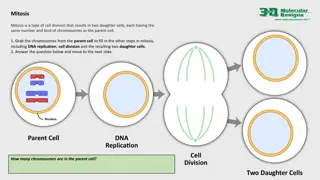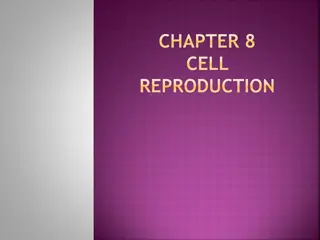Comprehensive Notes on Mitosis and Cell Division Process
Exploring the fascinating world of mitosis and cell division, this extensive collection of notes covers topics such as why cells need to divide, the cell cycle, interphase phases (G1, S, G2), and the essential process of mitosis in somatic cells. Supported by vivid images, the content delves into the intricate mechanisms that drive cellular growth and replication, making learning about these fundamental biological processes engaging and informative.
Download Presentation

Please find below an Image/Link to download the presentation.
The content on the website is provided AS IS for your information and personal use only. It may not be sold, licensed, or shared on other websites without obtaining consent from the author.If you encounter any issues during the download, it is possible that the publisher has removed the file from their server.
You are allowed to download the files provided on this website for personal or commercial use, subject to the condition that they are used lawfully. All files are the property of their respective owners.
The content on the website is provided AS IS for your information and personal use only. It may not be sold, licensed, or shared on other websites without obtaining consent from the author.
E N D
Presentation Transcript
Mitosis (cell division) O M G . More notes? Sweet! I m telling you, Captain Science, there is nothing I would rather do than take notes on a Monday morning. I was thinking the best thing about today was going to be food, but this is soooo much better. Well except for chocolate. It s not quite as good as that, but close. (It s definitely better than white chocolate, but that s not really chocolate anyhow. It s just yogurt pretending to be chocolate. Gross. And speaking of chocolate, Mr. Mason likes dark chocolate. Just FYI.) Anyhow yeah! Notes! Woohoo!!!
Why do cells need to divide? The work of the cell occurs at the boundaries, and the cell membrane grows more slowly than the volume as cell size increases.
Why do cells need to divide? The work of the cell occurs at the boundaries, and the cell membrane grows more slowly than the volume as cell size increases. What if Anchorage doubled in size but it didn t add any new roads, airports, or ports? What if it tripled in size?
Mitosis Mitosis The process of cell replication in somatic (body) cells
Interphase Cell spends the majority of life in interphase
Interphase Cell spends the majority of life in interphase G1: Cells grow to mature size (growth phase)
Interphase Cell spends the majority of life in interphase G1: Cells grow to mature size (growth phase) S: Cell s DNA is copied (synthesis phase)
Interphase Cell spends the majority of life in interphase G1: Cells grow to mature size (growth phase) S: Cell s DNA is copied (synthesis phase) G2: Cell prepares for division
Interphase Cell spends the majority of life in interphase G1: Cells grow to mature size (growth phase) S: Cell s DNA is copied (synthesis phase) G2: Cell prepares for division G0: ???
Interphase Cell spends the majority of life in interphase G1: Cells grow to mature size (growth phase) S: Cell s DNA is copied (synthesis phase) G2: Cell prepares for division G0: Cell exits cell cycle. Cells are not copying DNA or preparing to divide. (The vast majority of the body s cells are in G0, simply doing their job instead of preparing to divide.)
Mitosis Mitosis The actual process of division, broken into 5 steps: Prophase Metaphase Anaphase Telophase Cytokinesis
1. Prophase Chromatin (loose, uncoiled DNA) coils into tightly wound chromosomes Sister chromatids (identical copies of chromosomes) held together by a centromere. Nuclear membrane breaks down and disappears. Centrioles move to opposite poles and spindle fibers start to extend.
2. Metaphase Chromosomes move to the equator of the cell Spindle fibers connect to chromosomes at the centromere
3. Anaphase The sister chromatids separate and move towards the opposite poles, pulled by shortening spindle fibers
4. Telophase Chromatids reach the opposite ends of cell Mitotic spindle disappears Chromosomes start to uncoil into chromatin Nuclear envelope starts to reform
Cytokinesis Cell membrane pinches inward at the cleavage furrow*, eventually splitting the one original cell into two daughter cells (*no furrow evident in plant cells a new cell wall is built between the two new daughter cells)























